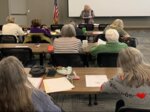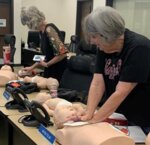


For the past seven years, one local program has been bridging the GAP — literally — for teens who are turning 18 and aging out of the foster care system.
But recently, Hood County’s foster mentoring program has added three new services to help teens reach their true potential.
The GAP foster program was developed in 2017 by the Granbury Service Extension Unit of The Salvation Army to offer various types of support to help foster teens successfully transition into adulthood.
Mentors help teens transition through high school and prepare them for independent life after graduation, whether they decide to head to college or choose a career field.
NEW PROGRAMS
While the program has been successful since the beginning, GAP Director Mary Flores recently came up with the idea of bringing in special speakers to educate the mentors on specific topics, like scholarships and finances.
"It really opened up the volunteer's eyes that if we educate these teens now, how far off they will be when they're in their 40s and 50s,” she explained. “But they had to learn about it, so those kinds of speakers have helped our volunteers to better serve our teenagers."
Another change for 2024, Flores said, is for the program to assist individuals who are a part of kinship placements, in which Child Protective Services places a child with a kinship caregiver (relative or an adult who has a significant relationship with the child), according to the Arizona Department of Child Safety.
"When they're in that home, sometimes they stay in that home, they close those cases, and they're not seen anymore. But sometimes the deputies are getting calls about grandmas who don't know what to do,” she explained. “I want to make sure we have support for these families, grandmas or aunts and uncles, where these mentors can come and take the teens to the movies, or take them to learn about work, banking, savings and budgeting. These people need that extra help. That's why it's called the GAP program. We're filling in the gap wherever there is a need in our community."
Flores said 355th District Judge Bryan Bufkin and Child Protection Judge David Barkley also started allowing herself and GAP administrative assistant Carol Grigson to go into the courtroom to witness some of the foster teen proceedings.
“We were kind of keeping our distance from that because that's what CASA (Court Appointed Special Advocates) does, but it also helps us all partner up and get to know what's going on with the families,” Flores said. “We'll all be on the same page.”
HISTORY
In 2017, Flores and friend, Sally Timmons, went out into the community and researched for a way that the Salvation Army could “fill in the gap,” so to speak. After interviewing nonprofits, organizations and churches, they found that the top need was foster kids aging out of the foster system with no support — essentially, they were becoming homeless.
According to the National Foster Youth Institute, the child welfare system is sometimes described as a highway to homelessness. An estimated 20% of young adults who are in care become homeless the moment they’re emancipated at the age of 18. And nationwide, 50% of the homeless population spent time in foster care.
“What we can do to prevent them from being homeless is what our goal is, especially when they don't have family or any kind of support if they aged out,” Flores previously told the Hood County News. “We need more time invested in the kids to make sure that we have a plan when they age out, that they have a place to stay, they have identification, if they should be on Social Security, disability and Medicaid. That's our goal — making sure that they don't fall through the system, making sure they have housing.”
After the pair spent a year advocating for and presenting the program, the GAP program was approved Feb. 2, 2018. Eleven volunteers were trained June 6, 2018, and the GAP program received its first teen Nov. 8, 2018.
Since then, several teens have gone through the program, with the longest being about four years, Flores said.
"They stay in the program for a long time until we feel like those needs are being met and we graduate them out,” she explained. “Or if they get adopted, we graduate them from the program because they're done."
The program has two components: Pre-GAP, which encompasses teens ages 13-18 in grade eight through their senior year, and the GAP program, for teens ages 17 in grade 12 to age 23.
“We do mentor younger teens, like preteens, and it's trying to build that relationship,” Flores said. “We don't want to wait until they're 18 and they're already aging out of the foster system. We want those relationships to start building a little bit younger.”
GAP MENTORS
Each foster teen is paired with two volunteer mentors who provide guidance support. Mentors commit one year of dedicated service to helping teens. They help the teen navigate situations many take for granted, including basic life skills like finding a job, getting a driver license, opening a bank account and much more.
Flores explained that she came across a foster teen who was living at the homeless shelter in Oak Trail Shores and had no identification. However, with the help of Sen. Brian Birdwell, the GAP Program was able to get him the extra help and attention he needed until he turned 23.
"That was a cut-off age for him,” she explained. “Because of his disability, we extended his time a little bit longer than most kids.”
The day of his graduation from the program, Flores said he only asked for one thing: a “forever family” — something that the GAP Program unfortunately could not provide.
"That's one thing we couldn't give him because he wasn't adopted,” Flores said. “But we told him, ‘If you do get married, you can invite us, and we'll be a part of your life as long as you want us to be.’”
Mentors in the GAP foster program also have access to scholarship funds that may be used to assist with the teens’ extracurricular activities, clothing, personal hygiene, and medical and dental assistance, based on the teens’ goals. Each scholarship has a set, limited amount per year.
A GAP mentor gets to know a foster teen and everyone involved in the teen’s life to advocate for the teen’s best interests while in the foster care system. Good mentors do not take this responsibility lightly and work to become invested in the success of the teen. By volunteering a few hours a month, mentors can make a tremendous difference in a teen’s life.
Flores said one teen who was adopted out of the program about a month ago wrote a heartwarming note about two of the volunteers and how they taught her life skills. She wrote, “They made me feel very special and always put my wants first. Both of them inspired me to pretty much go forward into law and encouraged me to continue my passion about art and reading, even doing the hard things when I don't really want to do. Everyone deserves to have amazing mentors, like I did with these wonderful ladies.”
“One of the things that she said on here was that ‘They helped me emotionally connect with God again,’ and as victims, even myself as a survivor, some of the things that I witnessed, I didn't believe in God,” Flores said. “Because you think if there was a God, then why was I in that situation? But when I gave God a chance, that's what makes me help kids, is because of what I went through. I don't want them to feel like that's it. There is hope at the end of the dark tunnel. There are ways that you can give back to the community — and that's what I do.”
To be eligible to serve as a GAP program mentor, volunteers must be at least 30 years old, they must pass the Salvation Army and CPS background checks, and they must participate in required mentor training.
GAP program volunteers will be assigned a partner (if one is available) or they may find or choose their own partner. They also must agree to several commitments before becoming a mentor, like:
To become a mentor, volunteers will need to submit an application to the Salvation Army website at salvationarmyusa.org. Once they submit an application, a background check will be conducted. Following approval of the background check, volunteers will then be required to undergo training.
“Training consists of trauma, CPR, AED, (automated external defibrillator) an overview of the foster system and Safe from Harm,” Flores said. “Those are your main ones, but then they continue having training throughout the year.”
Currently, there are 26 volunteers in the program who are either mentoring or preparing to graduate from their training.
Last year, Flores said GAP program mentors had logged a total of 821 hours, 44 minutes to assist their teens, which she said is astounding considering that many of the teens live as much as six hours away.
“It's not easy,” Flores said, in a previous interview with the HCN. “I mean, these mentors are taking on these kids and they really become part of a family.”
Flores added that her main goal is to have a GAP program in every county in Texas.
“Salvation Armies are everywhere in the United States,” she added. “We're blessed with Granbury having the funding to support the program through Salvation Army."
For more information about the GAP program, visit salvationarmyusa.org online.